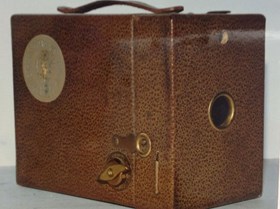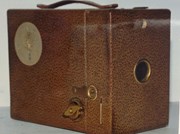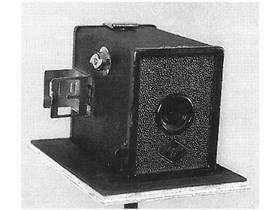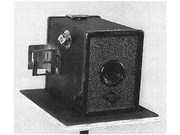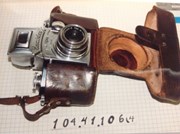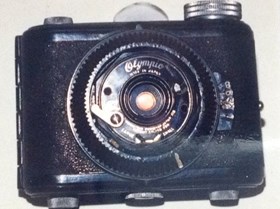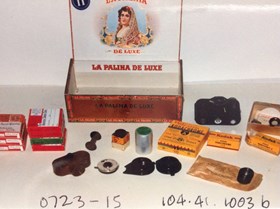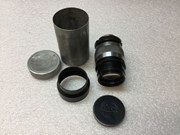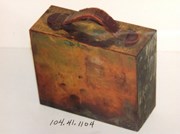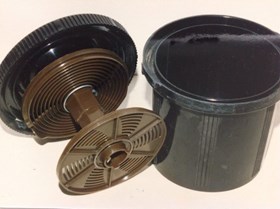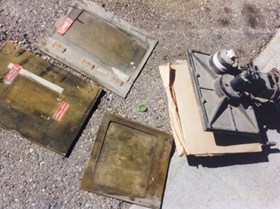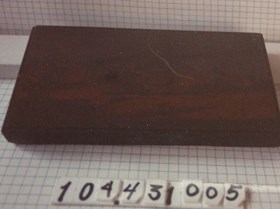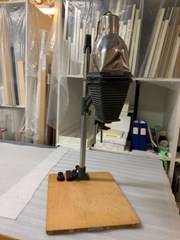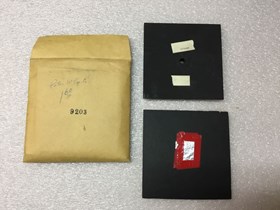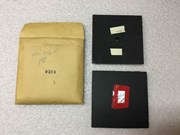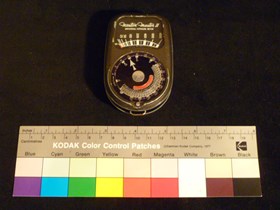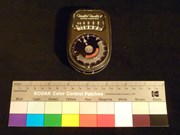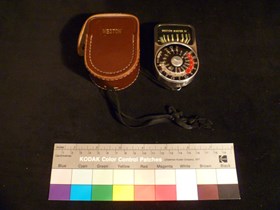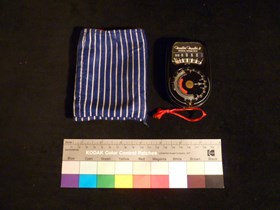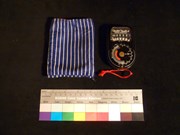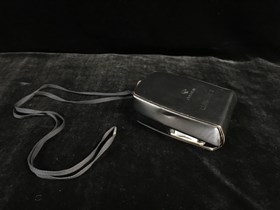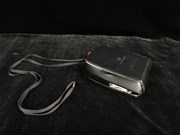Narrow Results By
- Date
- 1930 – 1940
- Material
- cardboard, leatherette; glass, metal;
- Catalogue Number
- 104.41.1053
- Description
- Kodak Anniversary box camera; brown, textured leather covered cardboard for body; leather strap on top;viewfinder window; body back clip top; viewfinder lens; internal lens front; body back clip; shutter release; film advance; foil decal commemorating 50th Anniversary on side; amber window at back.
1 image
- Title
- Box Camera
- Date
- 1930 – 1940
- Material
- cardboard, leatherette; glass, metal;
- Dimensions
- 14.7 x 11.1 x 8.4 cm
- Description
- Kodak Anniversary box camera; brown, textured leather covered cardboard for body; leather strap on top;viewfinder window; body back clip top; viewfinder lens; internal lens front; body back clip; shutter release; film advance; foil decal commemorating 50th Anniversary on side; amber window at back.
- Subject
- photography
- Credit
- Gift of Robert N. Smith, Canmore, 1985
- Catalogue Number
- 104.41.1053
Images
This material is presented as originally created; it may contain outdated cultural descriptions and
potentially offensive content.
Read more.
- Date
- 1938
- Material
- metal; glass; paper
- Catalogue Number
- 104.41.1113 a,b
- Description
- A simple black box camera with black, simulated textured leather. It also has an adhesive-taped, original box. The inverted aperture in the front has a black metal retention ring surrounding it. Below this “Agfa” is imprinted on the camera, surrounded by a diamond-shaped box. There is a black metal…
1 image
- Title
- Box Camera
- Date
- 1938
- Material
- metal; glass; paper
- Dimensions
- 8.5 x 6.5 cm
- Description
- A simple black box camera with black, simulated textured leather. It also has an adhesive-taped, original box. The inverted aperture in the front has a black metal retention ring surrounding it. Below this “Agfa” is imprinted on the camera, surrounded by a diamond-shaped box. There is a black metal rim which overlaps the edges on the front of the camera; on both sides there is a slight extension, .03 x.05 wide, 2.0cm from the top, with a hole in the metal. This fits over two small metal knobs on each side of the camera body. It appears that pushing the knobs in and pulling, would release the front part of the camera from the body. On the viewer’s left is the metal shutter release; a small metal lever that can be pulled down to release the shutter and expose the lens from inside the body. On the same side is the metal film winder, 3.0cm from the front and .50cm from the top; this is a flat piece of metal 2.0cm in diameter, with arrows indicating the direction to turn (clockwise arrows), a round raised metal tab, onto which is screwed a piece of metal (2.5cmx1.0cm wide in the middle) to wind the film. It can also be pulled out to release the metal film chamber. The metal is turned down on the side of each end so the fingers can grasp it for turning. A metal folding viewfinder is .50cm from the back and 2.7cm from top and bottom; a flat piece of metal 3.0cm sq., folded at the sides, is rivetted onto the body. Two flat metal pieces are attached at each end, one on a spring to fold down; this piece is 2.4x2.7cm wide with a window cut out .50x1.0cm wide. The other piece is 2.7cm sq. with a window of 1.5x2.4cm wide; the cutout has a piece of metal raised from the bottom of the window. The cutout is for perspective when you look through the viewfinder, vertically or horizontally. This piece of metal folds down to become the top, effectively making the viewfinder flat when not in use. There is a hinged door on the back of the camera and a cut-out metal latch on the door that connects to a small metal knob 1.0cm from the edge of the body. There is a red circle film window (1.0cm diagonally) which lets you read the frame number on the film. On the inside of the door are two rivets that connect the hinge. Above that and below the red circle, is a white painted circle with “USE AB” printed in black, overlapping a painted orange, blue, white, and yellow Agfa Plenachrome film box. The red viewfinder is 4.0cm from the base. A metal film chamber, with two metal rollers on each end for winding the film on, fits inside the camera. It can be released by pulling out the film winder. The canister is 7.0x5.0 wide, is open at one end, hollow in the centre, sloping upwards with a circular hole at the other end to let light in. There are two sprockets sitting on two cutouts on top of the canister and two on the bottom, onto which the film is winded. There are two rivets attaching two Y-shaped metal pieces, on either end that guide and let the film move and roll. The top of the camera has two metal knobs 1.5cm crosswise from each end, where a leather strap with a hole on either end, .07cm from the edge, fits in to make a diagonal strap/handle for carrying. The strap is imprinted with “A-8 CADET”. There is a small metal pull-up tab, 1.0cm from the edge of the front of the camera, that lets you time the shutter speed.
- Subject
- households
- photography
- hobbies
- Bob Louden
- Credit
- Gift of Bob Louden, Calgary, 2004
- Catalogue Number
- 104.41.1113 a,b
Images
This material is presented as originally created; it may contain outdated cultural descriptions and
potentially offensive content.
Read more.
- Date
- 1930 – 1940
- Material
- metal; glass; skin
- Catalogue Number
- 104.41.1064
- Description
- One Jhagee Exakta SLR 35mm with a leather case. This metal camera is built for a left-handed user.
1 image
- Title
- Camera
- Date
- 1930 – 1940
- Material
- metal; glass; skin
- Description
- One Jhagee Exakta SLR 35mm with a leather case. This metal camera is built for a left-handed user.
- Subject
- Byron Harmon
- photography
- Credit
- Gift of Jim Davies, Banff, 1991
- Catalogue Number
- 104.41.1064
Images
This material is presented as originally created; it may contain outdated cultural descriptions and
potentially offensive content.
Read more.
- Date
- 1885 – 1890
- Material
- wood; metal; skin
- Catalogue Number
- 104.41.1010 a,b
- Description
- “Premo D” folding camera (4”x5” format) with a leather covered wooden frame. The camera has a leather handle centred on the top and held in place with brass keepers. The hinged front of the camera opens to lie flat and has a brass track (3.2 cm wide) running down the centre. The red leather bell…
1 image
- Title
- Camera
- Date
- 1885 – 1890
- Material
- wood; metal; skin
- Dimensions
- 12.0 x 14.5 x 17.5 cm
- Description
- “Premo D” folding camera (4”x5” format) with a leather covered wooden frame. The camera has a leather handle centred on the top and held in place with brass keepers. The hinged front of the camera opens to lie flat and has a brass track (3.2 cm wide) running down the centre. The red leather bellows extend along the track and end with a wooden frame that holds a lens (missing) and a viewfinder. The camera also has hinged doors on the right side and on the back.b) Film plate holder loaded in the camera’s side chamber.
- Subject
- households
- photography
- hobbies
- Credit
- Gift of Unknown, 1968
- Catalogue Number
- 104.41.1010 a,b
Images
This material is presented as originally created; it may contain outdated cultural descriptions and
potentially offensive content.
Read more.
- Date
- 1930 – 1950
- Material
- metal, glass, leather
- Catalogue Number
- 104.41.1026
- Description
- miniature camera, case and film; black , die cast steel body; no glass; viewfinder, chrome lens; filmadvance; body back latch; empty film spool inside; brass with steel ends;"Belgium" stamp on either steel end; small red window on camera back; "TSLULCA" marked on lens front; leather case (16.7 x 8.…
1 image
- Title
- Camera
- Date
- 1930 – 1950
- Material
- metal, glass, leather
- Dimensions
- 3.8 x 5.7 x 4.3 cm
- Description
- miniature camera, case and film; black , die cast steel body; no glass; viewfinder, chrome lens; filmadvance; body back latch; empty film spool inside; brass with steel ends;"Belgium" stamp on either steel end; small red window on camera back; "TSLULCA" marked on lens front; leather case (16.7 x 8.5 x 8.2); zipper "Japan"stamped on leather; 2 rolls "ULCA Film" 8 exposure; made in Belgium; pinkcontainer with screws, glass discs, dial with "T B I" stamped onto surface.
- Subject
- photography
- Dr. Kennedy
- Credit
- Gift of Ernest Kennedy, 1968
- Catalogue Number
- 104.41.1026
Images
This material is presented as originally created; it may contain outdated cultural descriptions and
potentially offensive content.
Read more.
- Date
- 1930 – 1950
- Material
- metal, glass
- Catalogue Number
- 104.41.1025
- Description
- vest camera, Olympic; black, bakelite body; hinged back; release is small chrome button opposite hinge; chrome dials top and bottom; tripod mount; distance guide beside lensfocus ring; "Olympic" RODENSTEIN PERISKOP JAPAR 1:8" with large small lever inbetween, on lens; (lens is detached); 2 small or…
1 image
- Title
- Camera
- Date
- 1930 – 1950
- Material
- metal, glass
- Dimensions
- 4.3 x 9.1 x 7.4 cm
- Description
- vest camera, Olympic; black, bakelite body; hinged back; release is small chrome button opposite hinge; chrome dials top and bottom; tripod mount; distance guide beside lensfocus ring; "Olympic" RODENSTEIN PERISKOP JAPAR 1:8" with large small lever inbetween, on lens; (lens is detached); 2 small orange coloured windows on bodyblack steel spool inside. Made in Japan.
- Subject
- photography
- Dr. Kennedy
- Credit
- Gift of Ernest Kennedy, 1968
- Catalogue Number
- 104.41.1025
Images
This material is presented as originally created; it may contain outdated cultural descriptions and
potentially offensive content.
Read more.
Camera Accessories
https://archives.whyte.org/en/permalink/artifact104.41.1003%20b
- Date
- 1930 – 1950
- Material
- metal, glass, paper, leather
- Catalogue Number
- 104.41.1003 b
- Description
- 2 cigar boxes containing miscellaneous camera accessories:box b: wooden box "La Palina deluxe"; 7 boxes "Univex" 8 mm motion picturefilm; 3 developed, 4 unexposed; 1 box "Kodachrome" 16 mm motion picture film,unopened; 1 box "Verichrome" unopened; 1 box "Panchromatic-X" opened,unexposed; diaphragm …
1 image
- Title
- Camera Accessories
- Date
- 1930 – 1950
- Material
- metal, glass, paper, leather
- Dimensions
- 7.0 x 14.1 x 23.1 cm
- Description
- 2 cigar boxes containing miscellaneous camera accessories:box b: wooden box "La Palina deluxe"; 7 boxes "Univex" 8 mm motion picturefilm; 3 developed, 4 unexposed; 1 box "Kodachrome" 16 mm motion picture film,unopened; 1 box "Verichrome" unopened; 1 box "Panchromatic-X" opened,unexposed; diaphragm and shutter apparatus; silver film container, negativesinside; green label "Superpan"; black film in cut up box; film spool "Pathe"film strip viewer; filmstrip included; 2 green filters with lever; small boxwith circle cut one side, square with ground glass, circular box with squarecut, ground glass taped on; small lens in paper envelope; box withmiscellaneous parts; viewfinders, screws, washers, etc.
- Subject
- photography
- Dr Kennedy
- Credit
- Gift of Ernest Kennedy, 1968
- Catalogue Number
- 104.41.1003 b
Images
This material is presented as originally created; it may contain outdated cultural descriptions and
potentially offensive content.
Read more.
- Date
- 1931 – 1942
- Material
- metal; glass;
- Catalogue Number
- 104.41.0214
- Description
- Ernst Leitz Wetzlar Hektor f=7,3 cm 1:1,9 lens with hood and lens cap in a metal tube case. The lens cap has Leica engraved on it - the case has the manufacturer name and the lens size stamped on the lid, which slides up off the tube.
1 image
- Title
- Camera Lens
- Date
- 1931 – 1942
- Material
- metal; glass;
- Dimensions
- 8.6 cm
- Description
- Ernst Leitz Wetzlar Hektor f=7,3 cm 1:1,9 lens with hood and lens cap in a metal tube case. The lens cap has Leica engraved on it - the case has the manufacturer name and the lens size stamped on the lid, which slides up off the tube.
- Credit
- Gift of Catharine Robb Whyte, O. C., Banff, 1979
- Catalogue Number
- 104.41.0214
Images
This material is presented as originally created; it may contain outdated cultural descriptions and
potentially offensive content.
Read more.
- Date
- 1883 – 1926
- Material
- cardboard; metal; glass;
- Catalogue Number
- 104.41.0129 a,b
- Description
- Two camera lenses housed in a repurposed Hammond box with “OLD ‘ADON’ Telephoto in shutter circa 1990’s” written in black ink on the front.The larger lens with shutter was manufactured by Bausch & Lomb Optical Co., originally a company that produced prescription eye-wear in the mid to late-1800s be…
1 image
- Title
- Camera Lenses
- Date
- 1883 – 1926
- Material
- cardboard; metal; glass;
- Dimensions
- 5.7 x 7.8 x 14.5 cm
- Description
- Two camera lenses housed in a repurposed Hammond box with “OLD ‘ADON’ Telephoto in shutter circa 1990’s” written in black ink on the front.The larger lens with shutter was manufactured by Bausch & Lomb Optical Co., originally a company that produced prescription eye-wear in the mid to late-1800s before expanding into camera lenses and microscopes/telescopes towards the turn of the century. The company was founded in Rochester NY.The smaller lens was manufactured by Gundlach-Manhattan Optical Co., a merged company between Gundlach Optical Co. and Manhattan Optical Co. that took place in 1902, which produced various kinds of bellows cameras. Both companies were based in Rochester NY prior to merging.
- Credit
- Gift of Nicholas Morant, Banff, 2006
- Catalogue Number
- 104.41.0129 a,b
Images
This material is presented as originally created; it may contain outdated cultural descriptions and
potentially offensive content.
Read more.
- Date
- 1930 – 1949
- Material
- wood; metal; plastic
- Catalogue Number
- 104.41.0100
- Description
- Wood and metal Thalhammer camera tripod with metal spikes at the end of the legs, brackets at various points along the legs, and camera mount. The tripod is retracted to its shortest setting, but can double in height. Each leg has an adjustable metal bracket with circular knobs on the outside of th…
1 image
- Title
- Camera Tripod
- Date
- 1930 – 1949
- Material
- wood; metal; plastic
- Dimensions
- 88.8 cm
- Description
- Wood and metal Thalhammer camera tripod with metal spikes at the end of the legs, brackets at various points along the legs, and camera mount. The tripod is retracted to its shortest setting, but can double in height. Each leg has an adjustable metal bracket with circular knobs on the outside of the leg - the flat part of the knob features a kneeling man holding the handle of a long hammer in front of him, with his hands above his head just below the head of the hammer. This same logo is featured throughout other metal pieces around the head of the tripod. A plastic-handled grip is attached to the top of the tripod. Four circular pieces of paper screwed onto the camera support base, possibly as spacers, upon removal the Thalhammer company information is shown.
- Credit
- Gift of Nicholas Morant, Banff, 2006
- Catalogue Number
- 104.41.0100
Images
This material is presented as originally created; it may contain outdated cultural descriptions and
potentially offensive content.
Read more.
Cut-Film Holder
https://archives.whyte.org/en/permalink/artifact104.41.1104
- Date
- 1885 – 1900
- Material
- metal; skin
- Catalogue Number
- 104.41.1104
- Description
- Metal box with opening compartments and leather carrying handle marked “45”. “Pat. May 31. 87. Aug. 3. 90” stamped on top. Spring loaded film changing apparatus inside.
1 image
- Title
- Cut-Film Holder
- Date
- 1885 – 1900
- Material
- metal; skin
- Dimensions
- 4.5 x 11.5 cm
- Description
- Metal box with opening compartments and leather carrying handle marked “45”. “Pat. May 31. 87. Aug. 3. 90” stamped on top. Spring loaded film changing apparatus inside.
- Subject
- photography
- Vaux family
- Credit
- Gift of Molly Vaux, New York, USA, 1999
- Catalogue Number
- 104.41.1104
Images
This material is presented as originally created; it may contain outdated cultural descriptions and
potentially offensive content.
Read more.
Developing Tank
https://archives.whyte.org/en/permalink/artifact104.41.1059
- Date
- 1930 – 1950
- Material
- plastic
- Catalogue Number
- 104.41.1059
- Description
- Black plastic developing tank; black plastic cylinder with detachable lid; 6 groups of 4 ridges running the height of cylinder; lip surrounding opening at top; "PLANO" printed in relief on lid; 2 oblong holes to correspond to tongues on bottom section; olive colour spool with near spaced thread att…
1 image
- Title
- Developing Tank
- Date
- 1930 – 1950
- Material
- plastic
- Dimensions
- 12.0 x 12.4 cm
- Description
- Black plastic developing tank; black plastic cylinder with detachable lid; 6 groups of 4 ridges running the height of cylinder; lip surrounding opening at top; "PLANO" printed in relief on lid; 2 oblong holes to correspond to tongues on bottom section; olive colour spool with near spaced thread attached to lid with finger knob coming through to outside.
- Subject
- photography
- Credit
- Gift of Robert N. Smith, Canmore, 1985
- Catalogue Number
- 104.41.1059
Images
This material is presented as originally created; it may contain outdated cultural descriptions and
potentially offensive content.
Read more.
Dry Mounting Press
https://archives.whyte.org/en/permalink/artifact104.41.1067
- Date
- prior to 1950
- Material
- metal
- Catalogue Number
- 104.41.1067
- Description
- Metal press with handle, electrical cord (220). Three brass hinged mounting plates, 3 sizes.
1 image
- Title
- Dry Mounting Press
- Date
- prior to 1950
- Material
- metal
- Description
- Metal press with handle, electrical cord (220). Three brass hinged mounting plates, 3 sizes.
- Subject
- photography
- Byron Harmon
- Credit
- Gift of Don Harmon, Banff, 1994
- Catalogue Number
- 104.41.1067
Images
This material is presented as originally created; it may contain outdated cultural descriptions and
potentially offensive content.
Read more.
Engraving Plate
https://archives.whyte.org/en/permalink/artifact104.43.1005
- Date
- 1930 – 1970
- Material
- wood; metal, copper
- Catalogue Number
- 104.43.1005
- Description
- A rectangle of wood with a metal plate attached. The copper plate has an image on it.This item was transferred to the Archives by SS in May/June 2014.
1 image
- Title
- Engraving Plate
- Date
- 1930 – 1970
- Material
- wood; metal, copper
- Description
- A rectangle of wood with a metal plate attached. The copper plate has an image on it.This item was transferred to the Archives by SS in May/June 2014.
- Subject
- photography
- Credit
- Gift of Arthur Oliver Wheeler, 1975
- Catalogue Number
- 104.43.1005
Images
This material is presented as originally created; it may contain outdated cultural descriptions and
potentially offensive content.
Read more.
- Date
- 1930 – 1950
- Material
- wood; metal; plastic; glass;
- Catalogue Number
- 104.41.0163
- Description
- Metal Kodak Precision Enlarger mounted on a wooden board with power outlets and power switch mounted beside the base of the enlarger. The support arm mostly consists of a silver metal pole onto which the dull grey metal enlarger support is mounted - a plastic knob on one side allows the enlarger su…
1 image
- Title
- Enlarger
- Date
- 1930 – 1950
- Material
- wood; metal; plastic; glass;
- Dimensions
- 105.0 x 44.5 x 55.7 cm
- Description
- Metal Kodak Precision Enlarger mounted on a wooden board with power outlets and power switch mounted beside the base of the enlarger. The support arm mostly consists of a silver metal pole onto which the dull grey metal enlarger support is mounted - a plastic knob on one side allows the enlarger support to move up and down the support arm. The enlarger itself consists of a shiny metal dome with a fabric-wrapped power cord coming out the top [most likely the house for the light source] mounted on top of the grey metal frame [to which the enlarger support is attached] and into which several different negative trays can be fit, below the frame are dark grey fabric bellows that can be adjusted along a set of metal poles, the bottom of the bellows are attached to a smaller grey metal frame that also houses the focussing lens and a coloured filter that can be rotated in and out of frame.
- Subject
- Nicholas Morant
- photography
- photograph equipment
- camera equipment
- darkroom
- photograph developing;
- Credit
- Gift of Nicholas Morant, Banff, 2006
- Catalogue Number
- 104.41.0163
Images
This material is presented as originally created; it may contain outdated cultural descriptions and
potentially offensive content.
Read more.
- Date
- 1930 – 1960
- Material
- paper; cardboard; wood;
- Catalogue Number
- 104.51.1003
- Description
- Square manilla envelope with one wooden square and one cardboard square with unknown purposes inside. The envelope has “Peter Whyte” written in cursive above “1.60” written in pencil - “9203” is stamped in black in the middle. The wooden square has a hole drilled in the middle and angled edges, mak…
1 image
- Title
- Envelope
- Date
- 1930 – 1960
- Material
- paper; cardboard; wood;
- Dimensions
- 0.5 x 11.9 x 11.9 cm
- Description
- Square manilla envelope with one wooden square and one cardboard square with unknown purposes inside. The envelope has “Peter Whyte” written in cursive above “1.60” written in pencil - “9203” is stamped in black in the middle. The wooden square has a hole drilled in the middle and angled edges, making one side a slightly smaller square than the other, and there are two small pieces of white adhesive tape, one of which has random letters and numbers typed on it [possibly a spacer for a tripod]. The cardboard square has a small hole poked in the middle and blocked off on one side with what appears to be tinfoil taped down with several layers of red adhesive tape.
- Subject
- photography
- Peter Whyte;
- Credit
- Gift of Catharine Robb Whyte, O. C., Banff, 1979
- Catalogue Number
- 104.51.1003
Images
This material is presented as originally created; it may contain outdated cultural descriptions and
potentially offensive content.
Read more.
Exposure Meter
https://archives.whyte.org/en/permalink/artifact104.41.1118
- Date
- 1888
- Material
- metal; paint; plastic
- Catalogue Number
- 104.41.1118
- Description
- Hand held exposure/light meter made by Weston Electrical Instrument Company in a grey metal finish. Along both sides of the meter are a series of protruding lines that allow one to safely grip the object. At the bottom of the artifact there is a metal hook, which would have allowed a string to be a…
1 image
- Title
- Exposure Meter
- Date
- 1888
- Material
- metal; paint; plastic
- Dimensions
- 2.0 x 6.0 x 9.5 cm
- Description
- Hand held exposure/light meter made by Weston Electrical Instrument Company in a grey metal finish. Along both sides of the meter are a series of protruding lines that allow one to safely grip the object. At the bottom of the artifact there is a metal hook, which would have allowed a string to be attached like on the other Weston meter’s owned by Nicholas. There is also no longer a case to protect this particular object. In the top of the exposure meter there is a clear plastic covering. Along the very top there us the name of the manufacturer in white cursive lettering that reads “Weston Master II” and written underneath in capital letters “UNIVERSAL EXPOSURE METER.” Below this is the light scale where the value of the scene would be indicated. The scale contains the values “0” “25” “50” “100” “200” “400” “800” “1600,” which means that the two values on this instrument are calibrated 0-50 and 0-1600. (candles per square foot.)Below there is a circular face with several figures and a dial that turns/rotates. The outside row of figures on the exposure control dial represents the light value settings and corresponds to the light values on the light scale. Below the round dial there is a tiny circular button that is used to set the exposure control dial for film speed. As the dial turns it reveals the “EMULSION SPEED” with a red baize finish that has become worn throughout its life. The row of figures at the bottom of the top dial is the f/stop values and has an “f” to make this more apparent for the user. The row of figures directly below the f/stop settings are the shutter speeds. After setting the exposure control dial to the light value obtained on the light scale, any of the combinations of f/stop and shutter speed directly opposite each other are correct. On the rear of the meter there is a black plastic covering that contains several circular cut outs that are called a hir.ged baffle. This can be swung open (against the case) using the gold latch, which clips into a tiny hole or socket when the user wishes it to be closed. When opened the light sensitive photo cell is directly beneath this baffle and contains several protruding circles. When the baffle is open, the scale range is 0-50; when the baffle is closed, the scale range is 0-1600. Below there is an oval shaped face with extensive information that is held in place with two small screws on both the viewer left and right side. There is silver lettering on a black background that reads “WESTON ELEC. INST. CORP.” “NEWARK, N.J., U.S.A.” A silver backing separates the patent information and has black writing that reads “MODEL 735” on the viewer left side. On the viewer right side the number “7454510” is engraved. In the middle there is a gold-coloured screw with the words “ZERO CORRECTOR” written in black. Below this there is the patent information; “U.S. PATENTS” “2,274,441” “2,073,790” “2,346,555” “2,137,466” “2,463,770.” Below these numbers are the “FOREIGN PATENTS” “FRENCH 862,770” “BRITISH 531,996” “CAN. 347,085” “CAN. 411,975” At the very bottom underneath there is the manufacturer’s location; “MADE IN U.S.A.”
- Subject
- photography
- Nick Morant
- Credit
- Gift of Nicholas Morant, Banff, 2006
- Catalogue Number
- 104.41.1118
Images
This material is presented as originally created; it may contain outdated cultural descriptions and
potentially offensive content.
Read more.
- Date
- 1888
- Material
- leather; metal; nylon; plastic; thread; paint
- Catalogue Number
- 104.41.1119 a-b
- Description
- Hand held light meter in a pear shape with a stainless steel body and leather case. Along both sides of the meter are a series of protruding lines that allow one to safely grip the object. On the viewer right there is a pointer lock, which is locked when positioned upwards and released when positio…
1 image
- Title
- Exposure Meter
- Date
- 1888
- Material
- leather; metal; nylon; plastic; thread; paint
- Dimensions
- 2.0 x 5.0 x 9.0 cm
- Description
- Hand held light meter in a pear shape with a stainless steel body and leather case. Along both sides of the meter are a series of protruding lines that allow one to safely grip the object. On the viewer right there is a pointer lock, which is locked when positioned upwards and released when positioned downward. At the bottom of the artifact there is a metal hook, which has a black string running through. In the top of the light meter there is clear plastic covering. Written in capital letters is “WESTON MATER IV” above the light scale. The lights scale contains the numbers “0” “25” “50” “100” “200” “400” “800” “1600,” which means that the 2 values calibrated on this instrument are 0-50 and 0-1600.Below there is another light scale in the form of a circular face with several figures and a dial that turns/rotates. The dial on the outside has a series of protruding lines to make movement easier and contains a row of figures. This dial controls the lens aperture (f/stop) scale and has a series of values representing the focal length of the lens; “1” “1.4” “2” “2.8” “4” “5.6”. On the same dial there is also the letters “EVS,” which stands for the exposure value setting with a cut out window that reveals the EVS values. Working in a clockwise direction (on the same dial) there is also the letters “U,” “A with “1/2” over top,” an enclosed arrow that is known as the normal arrow, a “C” with “2x” on top of it, and a “0”. As this dial is turned it reveals a partly red baize and black numbers on a silver background that represents the shutter speeds in fractions of seconds. The inside dial has a series of light scale values and an exposure index window that line up with the “U,” “A,” normal arrow, “C,” and “0.” On the opposite side of the exposure index window is the exposure index knob. On the rear of the meter there is a black plastic covering that contains several circular cut outs that are called a hir.ged baffle. This can be swung open (against the case) using the gold latch, which clips into a tiny hole or socket when the user wishes it to be closed. When opened the light sensitive photo cell is directly beneath this baffle and contains several protruding circles. When the baffle is open, the scale range is 0-50; when the baffle is closed, the scale range is 0-1600. Below there is an oval shaped face with extensive information that is held in place with two small screws on both the viewer left and right side. There is black lettering on a silver background that reads “UNIVERSAL EXPOSURE METER” “MODEL 745” SER.W” and “107522” engraved. Below the manufacturer information is listed; “DAYSTROM. INCORPORATED” “WESTON INSTRUMENTS DIVISION”. “NEWARK. N.J.. U.S.A.” In the middle there is a gold-coloured screw with the words “ZERO CORRECTOR” written in black. On the viewer left side of the zero corrector there is patent information; “U.S. PATENTS” “2463770” and on the viewer right side “FOREIGN PATS” “CAN. 411975”. At the very bottom on either side of a circular cut out are “ASA” and “K=1.0” written. Underneath “MADE IN JAPAN” has also been written.There is also a brown leather case with this object. The front has “WESTON” written in gold letters. On the viewer left there is a brown button that allows the case to be opened or fastened shut. The leather has been stitched together with light brown thread that is visible. The bottom of the case has an opening for the black string to be strung through so that the light meter and case are attached. On the rear there is a brown leather strap stitched.
- Subject
- photography
- Nick Morant
- Credit
- Gift of Nicholas Morant, Banff, 2006
- Catalogue Number
- 104.41.1119 a-b
Images
This material is presented as originally created; it may contain outdated cultural descriptions and
potentially offensive content.
Read more.
- Date
- 1888
- Catalogue Number
- 104.41.1120 a-b
- Description
- Hand held light meter in a pear shape with a stainless steel body and leather case. Along both sides of the meter are a series of protruding lines that allow one to safely grip the object. At the bottom of the artifact there is a metal hook, which has a red string running through.There is a clear p…
1 image
- Title
- Exposure Meter
- Date
- 1888
- Description
- Hand held light meter in a pear shape with a stainless steel body and leather case. Along both sides of the meter are a series of protruding lines that allow one to safely grip the object. At the bottom of the artifact there is a metal hook, which has a red string running through.There is a clear plastic covering located at the top of the meter. Written in cursive letters is the company name “WESTON MATER II”. Underneath this written in capital letters is “UNIVERSAL EXPSOURE METER”. The light scale underneath contains the numbers “0” “25” “50” “100” “200” “400” “800” “1600,” which means that the 2 values calibrated on this instrument are 0-50 and 0-1600. Underneath the scale the word “Light” is present. Below there is another light scale in the form of a circular face with several figures and a dial that turns/rotates. The outside row of figures on the exposure control dial represents the light value settings and corresponds to the light values on the light scale at the top. The row of figures at the bottom of the top dial is the f/stop values and has an “f” to make this more apparent for the user.. On the same dial there is silver letters that have a line that correspond to the figures on the outside dial; “U,” “A with “1/2” underneath,” an arrow that is known as the normal arrow, a “C” with “2x” below it, and a “0”. As this dial is turned it reveals a partly red baize and the emulsion speed, which is self-evident as the words “EMULSION SPEED” are present. The row of figures directly below the f/stop settings are the shutter speeds. The outside row of figures is the light values, which is apparent as the word “LIGHT” with an arrow points to these values. After setting the exposure control dial to the light value obtained on the light scale, any of the combinations of f/stop and shutter speed directly opposite each other are correct. Below the round dial there is a tiny circular button that is used to set the exposure control dial for film speed.On the rear of the meter there is a black plastic covering that contains several circular cut outs that are called a hir.ged baffle. This can be swung open (against the case) using the gold latch, which clips into a tiny hole or socket when the user wishes it to be closed. When opened the light sensitive photo cell is directly beneath this baffle and contains several protruding circles. When the baffle is open, the scale range is 0-50; when the baffle is closed, the scale range is 0-1600. Below there is an oval shaped face with extensive information that is held in place with two small screws on both the viewer left and right side. There is silver lettering on a black background that reads “WESTON ELEC. INST. CORP.” “NEWARK, N.J., U.S.A.” A silver backing separates the patent information and has black writing that reads “MODEL 735” on the viewer left side; “No” is present in the middle; “8284703” is engraved on the viewer right side. In the middle there is a brass screw with the words “ZERO CORRECTOR” written in black around its circumference. On the viewer left side of the zero corrector is the patent information; “U.S. PATENTS” “1,779,574” “1,982,406” “2,073,790” and on the viewer right side continued patent information “U.S. PATENTS” “2,137,466” “2,274,441” “2,346,555”. Below these numbers are the “FOREIGN PATENTS” “FRENCH 862,770” “BRITISH 531,996” “CAN. 347,085” “CAN. 411,975” At the very bottom underneath there is the manufacturer’s location; “MADE IN U.S.A.” written in black on a silver background.There is also a blue case with white stripes and a red inner lining that would be used to protect the case. This would not have been originally sold with the exposure meter and was most likely hand made in an effort to protect the meter. Blue stitches hold the fabric together and are visible.
- Subject
- photography
- Nick Morant
- Credit
- Gift of Nicholas Morant, Banff, 2006
- Catalogue Number
- 104.41.1120 a-b
Images
This material is presented as originally created; it may contain outdated cultural descriptions and
potentially offensive content.
Read more.
- Date
- 1933 – 1949
- Material
- plastic; paint; leather; metal; fabric
- Catalogue Number
- 104.41.1123 a-b
- Description
- (a)Gossen Lunasix exposure and colour meter in a pear shape with leather case. The light meter device measures the amount of light that is appropriate to achieve the proper exposure, indicating for the users which shutter speed and f-number should be selected. Along the top of the exposure meter in…
1 image
- Title
- Exposure Meter
- Date
- 1933 – 1949
- Material
- plastic; paint; leather; metal; fabric
- Dimensions
- (a)2.5; (b)04.5 x (a)6.5; (b)7.5 x (a)11.5; (b)12.0 cm
- Description
- (a)Gossen Lunasix exposure and colour meter in a pear shape with leather case. The light meter device measures the amount of light that is appropriate to achieve the proper exposure, indicating for the users which shutter speed and f-number should be selected. Along the top of the exposure meter in the viewer left corner is a white bulb-like part next to an open circular window that measures the amount of light present in the scene. When the converter slide, located along the viewer right side, is moved to the right and clicked into position the round window is open and ready to read the scene. At the top, on the face of the meter, the light measurement (scale) is present. This shows how much light is present in the scene and directly relates to the remaining scales on the meter. Below the light scale is a plexiglass film-speed setting disc with grooves that allow the operator to easily move the dial. In the middle of the dial there is the Lunasix manufacturer symbol. On viewer left side of this emblem is the DIN exposure index of the film in use; on the proper right side of this emblem is the ASA exposure index of the film in use. By moving the dial one adjusts the film-speed setting, which is indicated in the DIN and ASA boxes, whereby the index number is lined up against the triangular white marker in the respective window. A manual would have originally been sold with the object giving a more comprehensive overview of the film-speed table with a technical appendix. On the rear of the object in the viewer right corner one will see the correct position of the 2 batteries indicated through a tiny diagram. Below this is a metal battery chamber. Below this are the words “2 Batt. Mallory” “PX 625 o. PX 13”. To the viewer left of this writing is the ridged slide used for battery testing. Above the ridged slide are the words “Batt. Contr.” with a solid arrow below. Below the battery information is the table of footcandle (LUX) equivalents. In the middle of the table is the zero adjustable screw with an arrow pointing in both directions. AT the very bottom painted on the surface is the location of manufacturing; “GERMANY (WEST)” above a cutout window revealing the patent number; “4D01673”. (b) There is also a black leather case with the object. The inside of the case has gray suede lining, which would have helped avoid scratching and marking of the meter. The case has been carefully designed to retrofit the meter, which is apparent through the tiny leather strap present when the case is opened. These designs allow the object to be formly held into place further safeguarding it. At the bottom of the case there is a black button that allows the case to be opened and fastened shut. When the case is fastened shut, the name of the manufacturer “Gossen” appears imprinted and is upside down. Below this, also upside down, “LUNASIX 3” has been applied in silver ink. Along the viewer right side the case has a cutout that perfectly fit the converter slide. On the rear “MADE IN GERMANY” appears in a receded box with protruding lettering. The bottom of the case, where the button is located, contains an opening for the black string to be strung through. The string, which has been tied to the exposure meter, measures 49.0 cm and has a metal piece holding the ends of the string in place. This would have given the user greater security when working with the exposure meter.
- Subject
- photography
- Nick Morant
- Credit
- Gift of Nicholas Morant, Banff, 2006
- Catalogue Number
- 104.41.1123 a-b
Images
This material is presented as originally created; it may contain outdated cultural descriptions and
potentially offensive content.
Read more.

